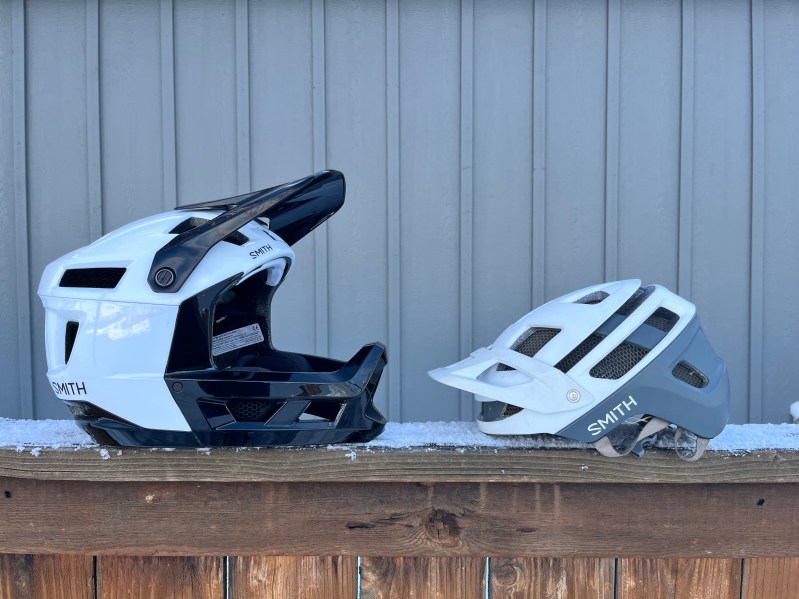
Typically, the mountain bike helmets are the section of the bike shop we venture into after buying a mountain bike. A quality helmet is paramount for all the mountain bike gear you can buy.
You will be hard-pressed to find anyone mountain biking without a helmet. If you do, others likely will not ride with them, not wanting to be involved in their blatant, unsafe behavior.
So, with helmets being a must, you are left with a decision: a half-shell or full-face mountain bike helmet. With this decision, you are probably asking questions like:
- Is a half-shell safe enough?
- Do I need a full face for the riding I do?
- Will I get laughed at if I have a full-face helmet?
So let’s take a look at the upsides and downsides of both mountain bike helmet styles so you can determine what is right for you.

Half-shell mountain bike helmet
Of all the mountain bike helmets, a half-shell helmet is the most popular. Go into any mountain bike shop, and you will see many options for half-shell helmets.
Half-shell helmets are the most popular because they are typically the only mountain bike gear needed to start mountain biking. It is doubtful that your first ride on a mountain bike will be on crazy terrain that would require the protection of a full-face helmet.
While a half-shell is likely the helmet you’ll get with your new mountain bike, it is essential to weigh the pros and cons of this type of helmet.
Pros
- Lots of options. With this being the most popular style of mountain bike helmet, you will likely find several half-shell choices within each brand.
- Lighter weight. Due to the more “minimalist” style, these helmets will be lighter than most of their full-face counterparts.
- Good protection. Many half-shells come standard with MIPS and other safety technology if you’re willing to pay.
- More breathable. Comfort is relative. A helmet that is comfortable on you may be wildly uncomfortable on another. But, without a doubt, you will sweat less in a half-shell.
- A bit cheaper. A half-shell will cost less than a full-face but can still be pretty spendy.
Cons
- Too many options. While it is nice to have all the options, many come with fewer built-in safety features. Although this typically saves you money, you’re left with a technically less safe helmet.
- Less coverage. A half-shell helmet leaves your chin, ears, and mouth very vulnerable. While we aren’t very likely to hit our face in a mountain bike crash, it does happen.
Full-face mountain bike helmet
At that same mountain bike shop, you will likely only see a few full-face helmets. While mountain bike helmet manufacturers will make several half-shell options, they probably only have one or two full-face helmet options.
So, is the full-face right for you? Let’s look at the pros and cons.
Pros
- More coverage. It isn’t called a “full face” for nothing. The chin bar addition to the mountain bike helmet helps protect your face. A full face also covers your ears and goes down further on the back of your head.
- More protection. More coverage = more protection.
- Highest levels of safety technology. Full-face helmets offer the most significant levels of protection. This means they will usually have all the safety features the manufacturer provides.
- More confidence. It may just be in your head, but when you feel safer, you ride more confidently.
Cons
- Tunnel vision. Your peripheral vision is eliminated in a full-face, meaning you have to turn your head to see anything out of your field of vision.
- Hard of hearing. Since a full-face mountain bike helmet covers your ears, it makes hearing much more difficult.
- Hot. You’re going to sweat in this helmet.
- Overkill. Depending on the trails you ride, others may consider a full-face too much.
- Typically, the most expensive. Get ready to pay.
Where do you mountain bike?
Aside from the pros and cons of these two mountain bike helmets, the trails you are mountain biking on may be an even more significant factor in your decision.
- How steep are the trails?
- How loose?
- Are their prominent features like jumps and drops?
- What are the overall speeds?
These are all questions you can ask yourself about the mountain bike trails you anticipate riding. You might consider a full-face helmet if there are big jumps, massive drops, and high speeds. A half-shell will likely do the job if your trails lean toward more pedal-y, cross-country-oriented riding.
And think about your whole ride. Is there a big singletrack climb to the top? A full-face may be unnecessary. Are you and your buddies doing shuttle runs or hitting bike park laps? That seems like a job for a full-face helmet.

Which mountain bike helmet? You decide
Obviously, there are pros and cons to whatever decision you make. A half-shell mountain bike helmet will be comfortable, and you will have many options, but they offer less protection.
A full-face helmet offers the most protection, but your sight and hearing will be restricted. They also cost more than the top-of-the-line half-shell mountain bike helmets do.
But, ultimately, the decision is yours. Even if you ride easier mountain bike trails, if you like the protection of a full-face helmet, wear it. Yes, it might be overkill, and you may never have a crash where you bash your face, but safety is the top priority.
If you are riding some gnarly mountain bike trails but want to wear a half-shell, that is fine, too. Perhaps having your peripheral vision is more important than maximum coverage.
Whether half-shell or full-face, the moral of the story is to wear a helmet.
Editors' Recommendations
- Every rider should know these mountain bike climbing basics
- The best long-distance bike trails across the U.S.
- 3 things you need to know about mountain biking in Sedona
- Is the PEARL iZUMi X-Alp Launch mountain bike shoe for you?
- This van life camper van sleeps 8, goes everywhere, and you can rent it for less than a hotel would cost





